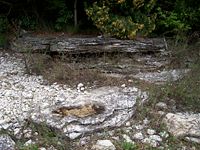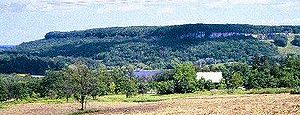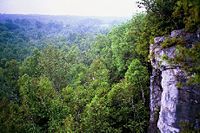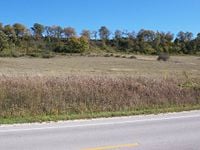Niagara Escarpment
The Niagara Escarpment is a long, precipitous, cliff-like ridge of land or rock in the United States and Canada that runs westward from New York State, through Ontario, Michigan, Wisconsin, and Illinois. It is composed of the Lockport geological formation of Silurian age. The escarpment is most famous for the cliff over which the Niagara River forms Niagara Falls, for which it is named.
The Niagara Escarpment is the most prominent of several escarpments formed in the bedrock of the Great Lakes. It is traceable from its easternmost point in New York State, starting well east of the Genesee River Valley near Rochester, creating waterfalls on the river in that city, then running westwards to the Niagara River forming a deep gorge between Lewiston, New York and Queenston, Ontario. In Southern Ontario it stretches along the Niagara Peninsula hugging close to the Lake Ontario shore through the cities of St. Catharines and Hamilton, where it takes a sharp turn north toward Georgian Bay. It then follows the Georgian Bay shore northwestwards to form the spine of the Bruce Peninsula, Manitoulin, St. Joseph Island, and other islands located in northern Lake Huron where it turns westerwards into the Upper Peninsula of northern Michigan, south of Sault Ste. Marie. It then extends southwards into Wisconsin following the Door Peninsula and then more inland from the western coast of Lake Michigan and Milwaukee ending northwest of Chicago near the Wisconsin-Illinois border.
In 1990, the Niagara Escarpment was designated a World Biosphere Reserve by the UNESCO.
Formation

Studies of rock exposures and drillholes demonstrate that there is no displacement of the rock layers at the escarpment. Thus, it is not a fault line but the result of unequal erosion. The Niagara Escarpment has a caprock of dolomitic limestone ("dolostone") which is more resistant and overlies weaker, more easily eroded shale as a weathering-resistant "cap." In other words, the escarpment formed over millions of years through a process of differential erosion of rocks of different hardnesses. Through time, the soft rocks weather away or erode by the action of streams. The gradual removal of the soft rocks undercuts the resistant caprock, leaving a cliff or escarpment. The erosional process is most readily seen at Niagara Falls, where the river has quickened the process. It can also be seen on the three waterfalls of the Genesee River at Rochester, New York (additional resistant rock layers make more than one escarpment in some places). Also, in some places thick glacial deposits conceal the Niagara Escarpment, such as north of Georgetown, Ontario, where it actually continues under glacial till and reappears farther north.
The dolostone cap was laid down as sediment on the floor of a marine environment. In Michigan, behind the escarpment, the escarpment capstone slopes gently to form a wide basin, the floor of an Ordovician-Silurian tropical sea. There the constant depositing of minute shells and fragments of biologically generated calcium carbonate, mixed with sediment washing in by erosion of the virtually lifeless landmasses eventually formed a limestone layer. In the Silurian, some magnesium substituted for some of the calcium in the carbonates, slowly forming harder sedimentary strata in the same fashion. Worldwide sea levels were at their all-time maximum in the Ordovician; as the sea retreated, erosion inevitably began.
Human geography
The Welland Canal allows ships to traverse the Escarpment between Lake Erie and Lake Ontario on the Niagara Peninsula of Ontario. The escarpment was a major obstacle in the construction of the Erie Canal in New York and was traversed by a series of locks; the community that grew up at the site thus became known as Lockport, New York.
In Southern Ontario, the Bruce Trail runs the length of the escarpment from Queenston (Niagara Peninsula) to Tobermory (Bruce Peninsula).
Hamilton, Ontario is situated on the escarpment in such a way that the north end of the city is below and the south part above. Affectionately referred to as "the mountain" by its residents, the escarpment is both an attraction and a hindrance to everyday life. Bridging the divide are a number of roads or "mountain accesses" that separate the urban core below from the suburban expansion above.
Ontario Greenbelt
The Ontario Greenbelt is a permanently protected area of green space, farmland, forests, wetlands, and watersheds, which wraps around the western end of Lake Ontario in Canada. The Greenbelt extends 202 miles from Rice Lake in Northumberland County to the Niagara River. It encompasses a significant portion of Canada's most populated and fastest-growing area—"The Golden Horseshoe"—where the population is expected to increase to about 11 million people from almost eight million over the next 30 years.
Created by legislation passed by the Ontario Liberal Government in 2005, the Greenbelt is considered a major step in the prevention of urban development and sprawl on environmentally sensitive land in the province. At over 1.8 million acres, the Greenbelt is larger than Canada's smallest province, Prince Edward Island. Its most prominent land features include the Niagara Escarpment, the Oak Ridges Moraine, and the Rouge Park.
Farming is the dominant land use in the Greenbelt and farmers are the dominant land owners at just over 50 percent. The Greenbelt’s natural heritage system protects about 535,000 acres of lakes, wetlands, river valleys, and forests. Habitat is protected for wildlife and endangered species within a continuous band of green countryside. Open space is maintained for tourism, recreation, and healthy living. Over 50 percent of people living in central Ontario are likely to take advantage of the tourism and recreation possibilities of the Greenbelt—hiking, camping, skiing, fruit-picking, wine-tasting, holiday tours, spas, and more.
Friends of the Greenbelt Foundation is a not-for-profit organization that was created to promote the greenbelt in Southern Ontario. A series of ads touting the benefits of the Greenbelt to the environment were aired on local radio stations in the Spring of 2006. Signs featuring the Greenbelt's promotional logo, created by designer Bruce Mau, are found along highways and regional roads where the Greenbelt is prominent.
Controversy
There has been considerable controversy over the Greenbelt. Most of the criticism comes from farmers and developers. The Greenbelt is designed to protect the environment, and clearly states that all agricultural land must be zoned as agricultural. Farmers have complained that it was their right to sell land to whomever they pleased, as anyone else could do it. Some protests were staged, particularly in Toronto.
Developers say that the Greenbelt artificially raises the prices for real estate. Because the expansion of the city is hindered by the Greenbelt in many places, the supply of real estate properties increases very slowly, while demand continues to rise quickly as Toronto's population grows. No plans to change the Greenbelt legislation have been put forward, other than plans for expansion.
Oak Ridges Moraine
The Oak Ridges Moraine is an ecologically sensitive geological landform in south central Ontario, Canada. The moraine covers a geographic area of 734 square miles between Caledon and Rice Lake, near Peterborough. One of the most significant landforms in southern Ontario, the moraine gets its name from the rolling hills and river valleys extending 99.4 miles from the Niagara Escarpment east to Rice Lake. It was formed 12,000 years ago by advancing and retreating glaciers. The moraine is currently a contested site in Ontario, since it stands in the path of major urban development.
Physiography
The Oak Ridges Moraine is a large ridge composed of four elevated wedges. It is bounded to the west by the Niagara Escarpment, which was critical to the formation of the moraine, and to the east by the Trent River and Rice Lake. The four wedges (Albion, Uxbridge, Pontypool, and Rice Lake from west to east) formed in stages, though some synchronous formation also occurred at an early period of formation. The moraine peaks at the Uxbridge wedge, generally rising from east to west, a result of the moraine's west-to-east formation. That is, the western portion of the moraine received earlier and more frequent sedimentary deposition than the eastern portion, as the ice lobes which controlled the moraine's eastern formation slowly retreated. The Rice Lake wedge is separated from the other wedges where the Oak Ridges moraine intersects Rice Lake.
Ecology
The ecologically diverse moraine is the source for many headwaters streams flowing south into rivers that drain into Lake Ontario and north into rivers that drain into Lake Scugog and Lake Simcoe. Varied landforms on the moraine, such as woodlands, wetlands, watercourses, kettle lakes, and bogs, have provided an environment suitable for significant flora and fauna communities to develop and thrive. The moraine contains one of the last large contiguous forested spans in southern Ontario.
Some of the wide variety of plant and animal species found in the moraine are species at risk in Canada and Ontario, including the West Virginia White Butterfly, Jefferson Salamander, Red-shouldered Hawk, and American Ginseng. The Hooded Warbler is a threatened species in Canada. Happy Valley Forests is one of the few remaining Canadian habitats for this species.
Unique ecosystems in the moraine include wetlands similar to those of boreal forests in Northern Ontario, and remnants of tallgrass prairie and oak-pine savanna that are globally threatened ecosystems. A typical portion of the moraine may be found in the Happy Valley Forests, in York Region, north of Toronto.
Development pressures
The greatest threat to the function of the Oak Ridges Moraine is land development on and below its surface, particularly in the headwaters. The estimated current population on the moraine land itself is roughly 200,000, but this number continues to grow at a frantic pace, with large urban developments occurring in Vaughan, Richmond Hill, and Aurora. Another five million people live in close proximity. Use of the moraine is currently under dispute; environmental groups such as the Sierra Club maintain the area's delicate ecosystems are threatened by development pressures. Attractive forests and hilly relief typical of the moraine are a magnet for developers looking for building opportunities in the densely populated Greater Toronto Area. However, many planners and residents see a need to preserve the moraine from the negative aspects of urban sprawl. Moreover, because it is a rich resource for sand and gravel, it has become a significant source of materials for the aggregate industry of the Greater Toronto Area.
Vineyard land
On the Canadian side of the border the Niagara Escarpment is a group-sub-appellation comprising the Short Hills Bench, The 20 Mile Bench and the Beamsville Bench. On the American side of the border the name defines an American Viticultural Area.
World Biosphere Reserve
In February 1990, the Niagara Escarpment was designated a World Biosphere Reserve by UNESCO, making it one of 12 in Canada. Development and land use adjacent to the escarpment is regulated and the biosphere protected by the Niagara Escarpment Commission, an agency of the Ontario government.
ReferencesISBN links support NWE through referral fees
- Gillard, William, & Tooke, Thomas. Niagara Escarpment, University of Toronto Press, 1975. ISPN 978-0802062147
- Kelley, Peter. E. The Last Stand: A Journey Through the Ancient Cliff-Face Forest of the Niagara Escarpment, Natural Heritage Books, 2007. ISBN 978-1897045190
- McLean, Ross. Country Walks: Niagara Escarpment, Boston Mills Press, 1994. ISBN 978-1550461022
- Reid, Ian. Land in Demand: The Niagara Escarpment, Book Society of Canada, 1977. ISBN 978-0772552402
External links
- Niagara Escarpment Commission
- Escarpment Coalition
- Escarpment Interprative Centre
- Lockport formation diagrams and rocks
- Wisconsin Geology Page- Niagara Escarpment
Credits
New World Encyclopedia writers and editors rewrote and completed the Wikipedia article in accordance with New World Encyclopedia standards. This article abides by terms of the Creative Commons CC-by-sa 3.0 License (CC-by-sa), which may be used and disseminated with proper attribution. Credit is due under the terms of this license that can reference both the New World Encyclopedia contributors and the selfless volunteer contributors of the Wikimedia Foundation. To cite this article click here for a list of acceptable citing formats.The history of earlier contributions by wikipedians is accessible to researchers here:
The history of this article since it was imported to New World Encyclopedia:
Note: Some restrictions may apply to use of individual images which are separately licensed.



